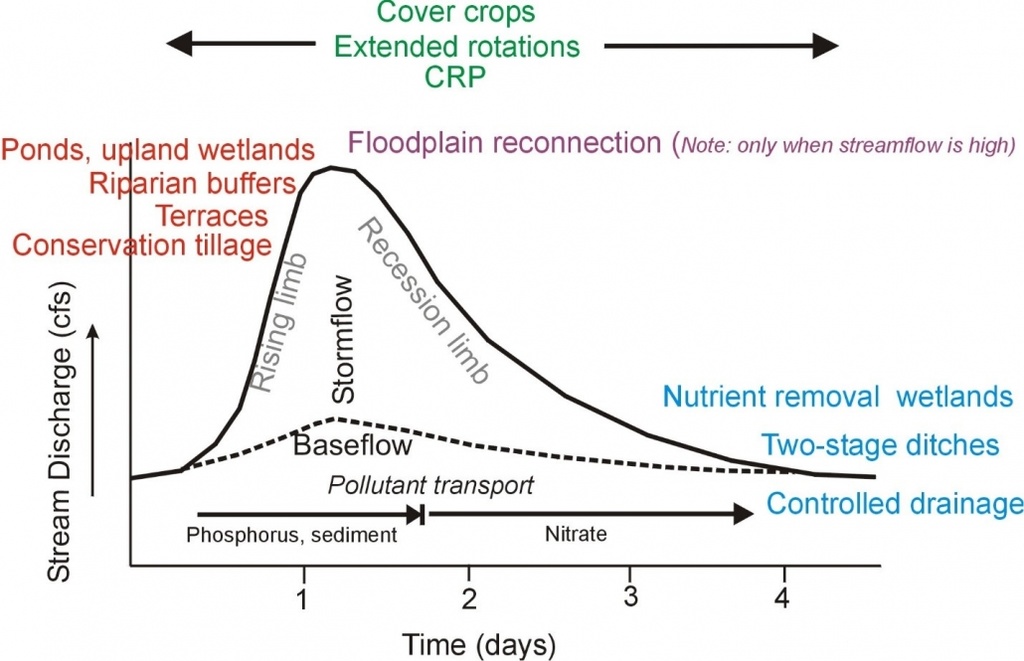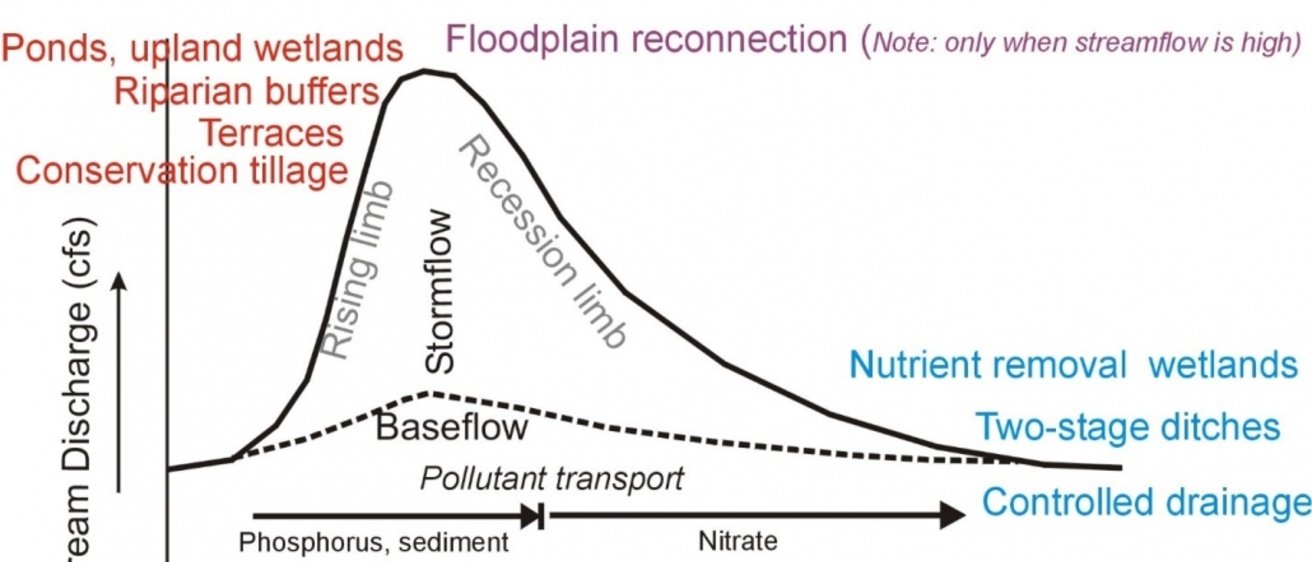Keith Schilling, State Geologist and Director, Iowa Geological Survey, University of Iowa
Increasing climate variability coupled with increasing demands for crop production are creating conditions ripe for increasing flood risks and accelerating nutrient and sediment export from agricultural watersheds. Improved “water farming” may be an important insurance policy for agricultural producers facing an unpredictable future. In this blog, I describe the concept of water farming and highlight how managing water yield from agricultural lands can be just as important as planting and harvesting.
To begin with, some background is needed. We all know that when it rains, water runs off the landscape, flows downhill and enters the nearest stream, thus causing the amount of flow in the stream to increase and the stream stage (water level) to rise. When stream discharge over time is plotted on a graph it is called a hydrograph (see Figure 1).

Streamflow is typically composed of two principal sources, the sustained groundwater discharge to a stream (baseflow) and the runoff delivered to a stream during a storm event (termed stormflow). It is the extra volume of water delivered to streams during rainfall events that causes the stream stage to increase and floods to occur. The rapid increase in stream discharge during runoff is termed the “rising limb” of the hydrograph and the slower decrease of discharge after the event has ended is termed the “falling limb”, or the recession (Figure 1).
Pollutant export is closely tied to the discharge hydrograph because water is the carrier of pollutants across the landscape. Pollutants like phosphorus and sediment that are associated with surface soil processes are carried to streams primarily with rainfall runoff, particularly during the rising limb of the hydrograph (Figure 1). On the other hand, nitrate-nitrogen (nitrate) is easily leached from soils and flows to streams with shallow groundwater and tile drainage. Nitrate concentrations will actually decrease during a storm event peak because of dilution from surface runoff and increase during hydrograph recession toward baseflow. So the hydrograph is also a good indicator of the mechanisms for transport and delivery of pollutants to streams.
So, with the terminology behind us, what does it mean to be a “water farmer”? Simply put, water farming means managing the water export from your land to minimize excess water loss and pollutant export. There is a myriad of conservation practices available to farmers to install on their lands, but we should recognize that these practices are designed to affect different parts of the streamflow hydrograph. A few of the practices are highlighted and placed on a typical hydrograph to show where they are designed to be most effective.
Many traditional conservation practices were designed to address soil erosion from agricultural fields. Because we know that soil erosion occurs during storm events, practices such as conservation tillage and terraces are designed to slow runoff from fields during the rising limb of the stormflow hydrograph. Similarly, riparian buffers slow water runoff from the edge of fields, whereas well-placed ponds and wetlands intercept and store rainfall runoff before it is delivered to a stream. When stormflow peaks high enough in some watersheds, discharge that was confined to the channel may escape into the channel floodplain to disperse flood water and drop out particulates. Floodplain reconnection practices focus on making it easier for floodwaters to enter their floodplains but this conservation practice only affects stormflow during high flow events. In the end, all of these practices affect the stormflow portion of the hydrograph, but have little to do with the baseflow contribution to streamflow. Water farming for flood mitigation focuses on these types of practices in an agricultural watershed.
On the other hand, several newer conservation practices are being designed to address the baseflow portion of the hydrograph when export of nitrate is prominent. Nutrient-removal wetlands are installed to intercept subsurface tiles and treat the nitrate-laden water before discharge to a stream. However, these systems are designed to pass stormflow runoff so the wetlands do not fill with sediment prematurely. Controlled drainage (managing water levels in tile drainage networks with gates and stop logs) and construction of two-stage ditches (making drainage ditches wider to accommodate more in-stream nitrogen processing) are similarly designed to affect nitrate concentrations during baseflow periods, not stormflow runoff periods. Water farming to reduce baseflow water delivery is primarily associated with reducing subsurface losses of nitrate.
Perhaps the most important conservation practices for “water farming” are those that affect both portions of the streamflow hydrograph. Practices that feature reintegration of perennial vegetation on the landscape, such as CRP, extended rotations of commodities with alfalfa, and cover crops, address both stormflow and baseflow water export (Figure 1). Surface roughness from perennial vegetation slows rainfall runoff and reduces the stormflow peak, while at the same time, increased evapotranspiration from perennial vegetation (mainly in the spring and fall when there are no crops) will reduce water yield and ultimately decrease nitrate losses to streams. Unfortunately, high land and commodity prices today are making it difficult to reintegrate perennial vegetation in many fields, so while these practices are effective, they are harder to implement.
So what conservation practices are best for a “water-farmer”? Like all answers from politicians and scientists (so it seems), it depends. It depends on what portion of the hydrograph you are interested in affecting or what issue you are seeking to address (flooding, phosphorus or nitrate export?). It is clear that conservation practices are not created alike so careful consideration is needed to pick and chose a practice that is best-suited for your concern. The key component needed for water farming is thinking about how water moves across your field and then designing a water management system that meets your goals.
